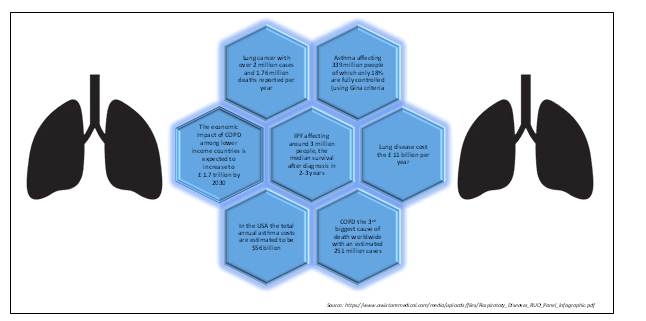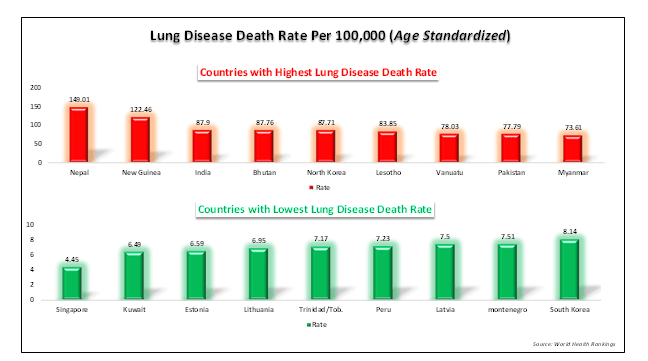- Home
- About Us
- Industry
- Services
- Reading
- Contact Us
AEROSOL TREATMENT MARKET SEEN SOARING 6% GROWTH TO REACH USD XX BILLION BY 2030, PROJECTS UNIVDATOS MARKET INSIGHTS
Author: Himanshu Patni
June 28, 2024
Key Highlights of the Report:
- The first powered or pressurized inhaler was invented in France by Sales-Girons in 1858.
- The particle size (expressed as mass median aerodynamic diameter) is of critical importance as the drug delivery.
- It is important to use an aerosol device that generates drug particles in the respirable range (1–5 μm) to maximize aerosol delivery to the lungs.
- Three key terms describe how well a patient follows a prescribed aerosol therapy: (1) Adherence, (2) Compliance, and (3) Contrivance.
- Even with the best technique, only 10% to 20% of the total drug makes it to the large airways and only 5% of the drug reaches the small airways.
- Patients may use aerosol therapy for a few days or a lifetime.
- Over the years, use of aerosolized medications has increased even in children.
According to a new report by Univdatos Market Insights, Aerosol Treatment Market, is expected to reach USD XX Billion in 2030 by growing at a CAGR of 6%. Numerous breathing disorders can be treated medically with aerosol therapy. Aerosol treatment can be used effectively in many different illnesses, but it requires a thorough grasp of its uses and guiding principles. Aerosol therapy is a treatment for conditions that affect the function of the airways, such as asthma and chronic obstructive pulmonary disease (COPD). It involves injecting tiny doses of medication into the lungs. These drugs work by relaxing the muscles of the airway to prevent infections and facilitate breathing. Patients may utilize aerosol therapy for a few days or for the rest of their lives, depending on their ailment or condition. Aerosol therapy, for example, may be used as a short-term treatment for patients suffering from acute respiratory illnesses like bronchitis or pneumonia, while it may be used as a long-term treatment for individuals suffering from chronic respiratory illnesses like COPD or asthma. Compressor or nebulizer use is necessary for aerosol therapy. A compressor, also called a nebulizer, is a device that simply allows a patient to inhale medication straight into their lungs by turning it from a liquid into a tiny, breathable mist.
The report suggests that the increasing respiratory diseases around the world is one of the major factors driving the growth of the aerosol treatment market during the forthcoming years. This organ is essential for the exchange of gases between the trachea (windpipe), lungs, diaphragms, and other parts of the human body. The body’s continuous ventilation is produced by all of these working in unison. The tissues and organs of individuals with respiratory diseases malfunction in the exchange of carbon dioxide and oxygen. It lowers the saturation point of oxygen (SpO2). Consequently, those who are affected feel nervous, lightheaded, confused, and disoriented. Diseases of the chronic respiratory system (CRDs) impact the lungs’ airways and other components. Asthma, occupational lung disorders, pulmonary hypertension, and chronic obstructive pulmonary disease (COPD) are among the most prevalent. Apart from tobacco smoking, additional risk factors consist of air pollution, dusts and chemicals from the workplace, and recurrent lower respiratory infections in children. While there is no known cure for CRDs, there are treatments that can assist manage symptoms and enhance daily life for those who have them. These treatments involve opening airways and improving breathing difficulties.
Obstructive vs Restrictive Respiratory System
Obstructive: When a respiratory condition causes congested or clogged airways, it is referred to as obstructive. This hinders the lungs’ ability to exhale. Common asthma triggers obstructive respiratory conditions that irritate airways, including stress, pollen, chemical gases, and other allergens.
Restrictive: When the lungs cannot expand to their full capacity, respiratory diseases are classified as restrictive. Pulmonary fibrosis, lung cancer, chronic obstructive pulmonary disease (COPD), and sarcoidosis are some examples of restrictive respiratory diseases.
For More Detailed Analysis in PDF Format, Visit-https://univdatos.com/get-a-free-sample-form-php/?product_id=55235

Fig1: Quick Facts About Respiratory Diseases
Different Types of Respiratory Disorders
Chronic Obstructive Pulmonary Disease (COPD): COPD is a type of lung disease that obstructs the air passage of the lungs, making it difficult to function effectively.
Asthma: Due to chronic coughing or other factors, the windpipes swell and narrow, impairing natural airflow in asthma.
Emphysema: The alveoli, or tiny air sacs in the lungs, deteriorate and may even rupture in emphysema patients.
Pleural Effusion: Commonly referred to as “water on the lungs,” occurs when surplus fluids build up between the pleural layers.
Chronic Bronchitis: Chronic bronchitis is a type of inflammation in the breathing tubes or bronchi.
What are the Causes of Respiratory Diseases
Smoking and Air Pollution: Smoking’s toxins and air pollution cause damage to the lungs’ alveoli (alveolar membrane). Therefore, it cannot properly immerse gaseous oxygen into the blood. As a result, the patients experience discomfort and shortness of breath.
Allergies: Some people’s immune systems react poorly to specific chemicals, such as pollen, dust, or animal dander. When allergic people are exposed to these allergens, they experience breathing difficulties.
Viral Infection: One of the main causes of respiratory disorders is viral infection. Some viruses enter alveoli and produce inflammation, such as influenza viruses, respiratory adenoviruses, and respiratory syncytial viruses.
Viral Infection: One of the main causes of respiratory disorders is viral infection. Some viruses enter alveoli and produce inflammation, such as influenza viruses, respiratory adenoviruses, and respiratory syncytial viruses.
Bacterial Infection: Respiratory diseases can also be brought on by some bacteria, including otitis, sinusitis, and pneumonia.
Product Type Segment of Aerosol Treatment Market
Aerosol delivery works at far lower levels than oral treatment and is noninvasive. Therapeutic aerosol delivery systems currently come in a variety of forms, such as nasal sprays, medical nebulizers, pressured metered-dose inhalers, dry powder inhalers, and solution mist inhalers. Therapeutic aerosols are administered via the nasal and oral inhalation routes. Only a small portion of the dose after inhalation therapy reaches the intended target area. When building a delivery system or devices to maximize the delivery efficiency to the intended region of the respiratory tract, knowledge of the actual amount of medicine deposited is crucial.

Fig2: Global Lung Disease Death Rate
Conclusion
Aerosol treatment can be used effectively in many different illnesses, but it requires a thorough grasp of its uses and guiding principles. Aerosol therapy is a treatment for conditions that affect the function of the airways, such as asthma and chronic obstructive pulmonary disease (COPD). The report suggests that the increasing respiratory diseases around the world is one of the major factors driving the growth of the aerosol treatment market during the forthcoming years. It lowers the saturation point of oxygen (SpO2). Aerosol delivery works at far lower levels than oral treatment and is noninvasive. Only a small portion of the dose after inhalation therapy reaches the intended target area.
Key Offerings of the Report
Market Size, Trends, & Forecast by Revenue | 2023−2030
Market Dynamics – Leading Trends, Growth Drivers, Restraints, and Investment Opportunities
Market Segmentation – A detailed analysis by product type and distribution channel
Competitive Landscape – Top Key Vendors and Other Prominent Vendors
Get a Callback
